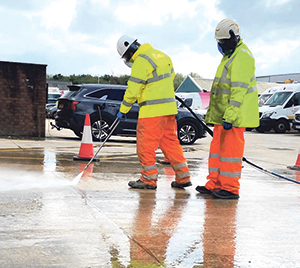Drainage engineers at Lanes Group plc are among the first operatives to undergo new training designed to develop essential knowledge and skills for when using water jetting for surface cleaning.
The Drain, Sewer and Surface Preparation up to 275 Bar practical module, or DSP for short, developed by the Water Jetting Association (WJA), includes new instruction on surface preparation.
Then course is designed to develop skills that discourage the use of washdown nozzles attached to jetting hoses. These have no mechanism for instantly shutting off the water supply in an emergency.
Safer water jetting
Lanes Group Training Manager, Darren Hamilton, has been putting new drainage engineers at Lanes through the course, which combines class and practical learning to enhance productivity and safety.
He said, “Drainage engineers often use water jetting to clean contaminated surfaces, for example to deal with sewage spills, or clean access chambers and open channels.
“We want to eradicate the use of washdown nozzles for these tasks. Water jets from guns is safer. It can be instantly stopped by releasing the trigger. This provides a built-in safety mechanism to control water delivery.
“Lanes aims to set the highest possible standards. By delivering this DSP practical module, we are aligning our training and procedures with the latest WJA red code of practice for drain and sewer cleaning, which incorporates this new thinking on surface preparation.”
Early adopter
All drainage operatives at Lanes, which is a member of the WJA, undergo WJA water jetting training before they are permitted to use water jetting equipment.
To achieve WJA certification, they must pass a Safety Awareness class-based course and at least one of five practical modules, of which the DSP course is the latest one.
Darren Hamilton is a WJA approved instructor. Until recently, he was also the WJA’s training and safety chairman, so played a key role in developing the new DSP practical module.
Surprised by power
The DSP module has two practical assessments: water jetting in drains and sewer pipes; and jetting for surface preparation up to 275 bar (4,000 psi) and water flow rates up to 73 litres per minute (lpm), within a maximum reaction force of 250 Newtons.
The pressure limit is set because drainage operatives commonly use lower pressures for washdown activities.
Topics covered include safe use of jetting equipment, water jetting techniques, jetting gun and nozzle types, risk assessment, use of protective clothing and equipment, site set-up, and emergency first aid.
T 0800 526488
sales@lanesgroup.co.uk
www.lanesfordrains.co.uk

